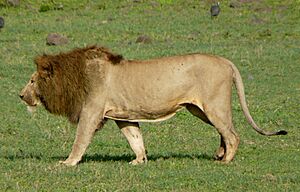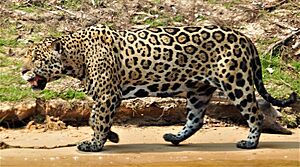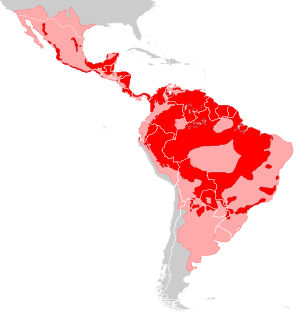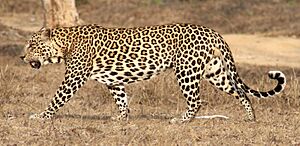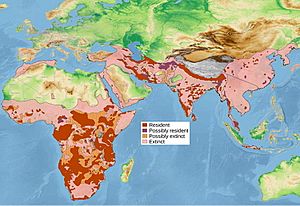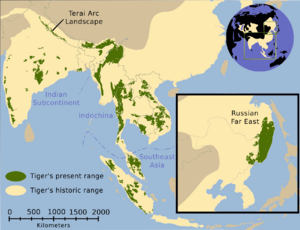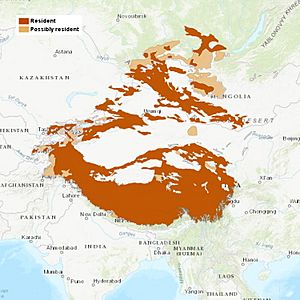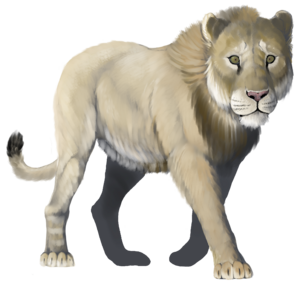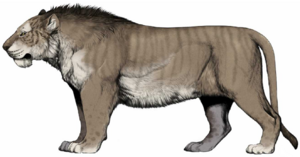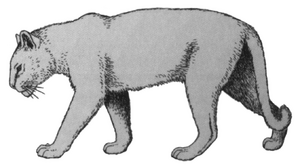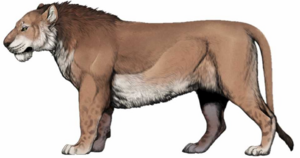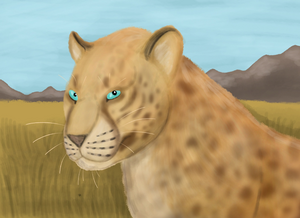Panthera facts for kids
Quick facts for kids Panthera |
|
|---|---|
 |
|
| From top to bottom: tiger, lion, jaguar, leopard, snow leopard | |
| Scientific classification |
|
| Kingdom: | Animalia |
| Phylum: | Chordata |
| Class: | Mammalia |
| Order: | Carnivora |
| Suborder: | Feliformia |
| Family: | Felidae |
| Subfamily: | Pantherinae |
| Genus: | Panthera Oken, 1816 |
| Type species | |
| Felis pardus (= Panthera pardus) Linnaeus, 1758
|
|
| Species | |
|
|
| Synonyms | |
Panthera is a group of large cats. It belongs to the cat family called Felidae. This group includes the biggest living cats on Earth. There are five living species in the Panthera genus: the jaguar, leopard, lion, snow leopard, and tiger. Many other species, like the cave lion and American lion, are now extinct.
Panthera species have unique features. Their skulls are usually flat or slightly rounded on top. The area between their eyes is not very high. Also, the back part of their skull slopes gently.
Contents
What Does Panthera Mean?
The word panther comes from an old Ancient Greek word. It was pánthēr in Ancient Greek. Later, it became panthēra in Classical Latin.
How They Roar
All Panthera cats have a special hyoid bone in their throat. This bone is not fully hardened. They also have a unique larynx (voice box). It has large, strong vocal folds. These features allow them to make a loud sound called a roar.
The snow leopard is the only exception. It cannot roar like the others. Its vocal folds are shorter, only about 9 millimeters long. This makes it harder for them to produce a roar.
Other Sounds They Make
Panthera cats can also prusten. This is a soft, snorting sound. They use it when they greet friendly cats. The roar is a very loud call. Its sound pattern is different for each species.
How Panthera Cats Evolved
Scientists are not sure where Panthera cats first appeared. The oldest known Panthera species is Panthera principialis. Its fossils were found in Tanzania.
Early Cat Ancestors
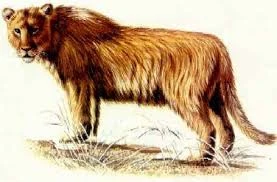 Genetic studies show that big cats like Panthera separated from smaller cats. This happened between six and ten million years ago. The clouded leopard is a close relative. It split off about 8.66 million years ago.
Genetic studies show that big cats like Panthera separated from smaller cats. This happened between six and ten million years ago. The clouded leopard is a close relative. It split off about 8.66 million years ago.
The Panthera group itself split from other cats about 11.3 million years ago. Then, the different Panthera species evolved. The tiger appeared about 6.55 million years ago. The snow leopard came about 4.63 million years ago. The leopard evolved about 4.35 million years ago.
Extinct Relatives
Fossils suggest the American lion (P. atrox) is related to the Eurasian cave lion. They separated about 0.34 million years ago. Both are closely related to modern lions. The snow leopard is also closely related to the tiger.
The extinct species Panthera gombaszoegensis was likely related to the modern jaguar. Its first fossils were found in Italy. They date back 1.6 million years.
How Panthera Cats Are Classified
Lorenz Oken first named the Panthera group in 1816. He put all spotted cats in this group. Over time, many different types, or "races," were suggested.
Modern Classification
In 1916, Reginald Innes Pocock reviewed the group. He classified it to include the tiger (P. tigris), lion (P. leo), jaguar (P. onca), and leopard (P. pardus). He based this on features of their skulls.
Later, genetic studies showed that many lion and leopard types were very similar. So, scientists grouped them together. For example, all African leopard populations are now P. p. pardus.
In 2008, the snow leopard (once called Uncia uncia) was officially moved into the Panthera genus. It is now called P. uncia.
Black Panthers
A black panther is not a separate species. It is a melanistic (dark-colored) version of a leopard or jaguar. They have extra dark pigment in their fur.
Living Panthera Species
Here are the main living species of Panthera:
| Species | Subspecies | IUCN Red List status and distribution |
|---|---|---|
| Lion P. leo (Linnaeus, 1758) | P. l. leo (Linnaeus, 1758) including:
P. l. melanochaita (Smith, 1842) including:
|
Vulnerable species |
| Jaguar P. onca (Linnaeus, 1758) | Monotypic | Near-threatened species |
| Leopard P. pardus (Linnaeus, 1758) | African leopard P. p. pardus (Linnaeus, 1758) Indian leopard P. p. fusca (Meyer, 1794) |
|
| Tiger P. tigris (Linnaeus, 1758) | P. t. tigris (Linnaeus, 1758) including:
Sunda Island tiger P. t. sondaica Temminck, 1844) including
|
Endangered species |
| Snow leopard P. uncia (Schreber, 1775) | Monotypic |
Extinct Panthera Species
Many Panthera species are now extinct. Here are some notable ones:
| Species and subspecies | Where and When They Lived | Notes | Images | |
|---|---|---|---|---|
| Panthera atrox | North America, 130,000 to 13,000 years ago. | Also known as the American lion. It was one of the largest Panthera species. It became extinct around 13,000-12,000 years ago. | ||
| Panthera fossilis | Europe and Asia, 680,000 to 250,000 years ago. | An extinct lion species. It was one of the largest Panthera species. Scientists think it was an ancestor of the cave lion. | ||
| Panthera gombaszoegensis | Europe, possibly Asia and Africa, 2 million to 350,000 years ago. | Often called the "European jaguar." It might be an ancestor of the living jaguar. | ||
| Panthera spelaea | Much of Eurasia, 600,000 to 13,000 years ago. | Commonly known as the cave lion or steppe lion. It is closely related to the modern lion. It became extinct around 14,500-14,000 years ago. | ||
| Panthera onca augusta | North America | This extinct jaguar may have lived in temperate forests. | ||
| Panthera onca mesembrina | South America | This extinct jaguar may have lived in grasslands. | ||
| Panthera pardus spelaea | Europe | This extinct leopard was closely related to Asian leopard types. |
Family Tree of Panthera Cats
Scientists use genetic research and fossil studies to understand how Panthera species are related. This helps them create a family tree, or phylogenetic tree.
| Panthera |
|
|||||||||||||||||||||||||||||||||||||||||||||||||||||||||||||||||||||
See also
 In Spanish: Panthera para niños
In Spanish: Panthera para niños
- Panthera hybrid
- Panther (legendary creature)


